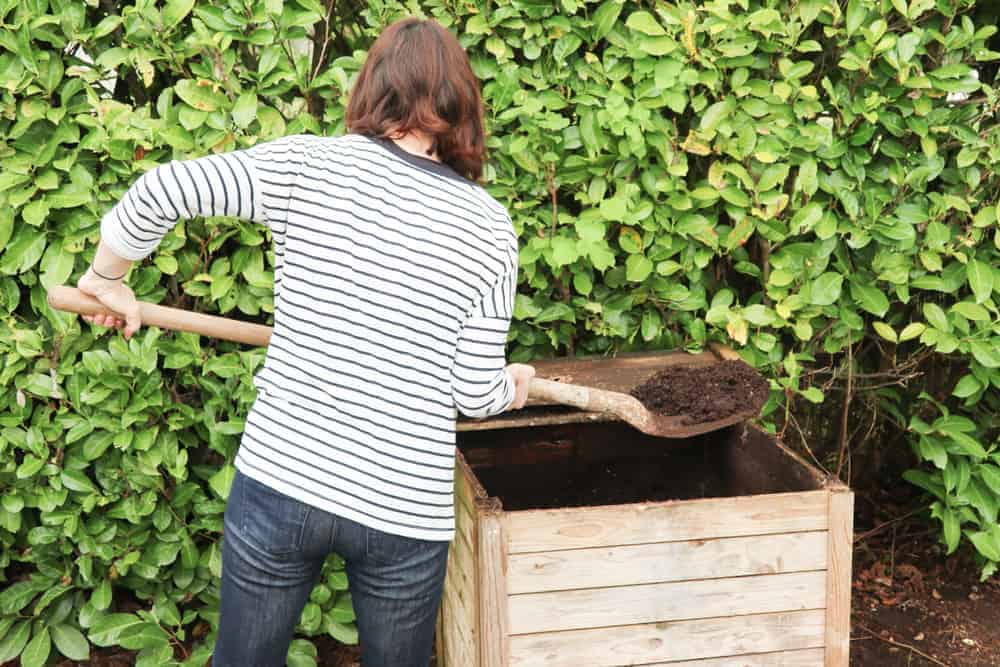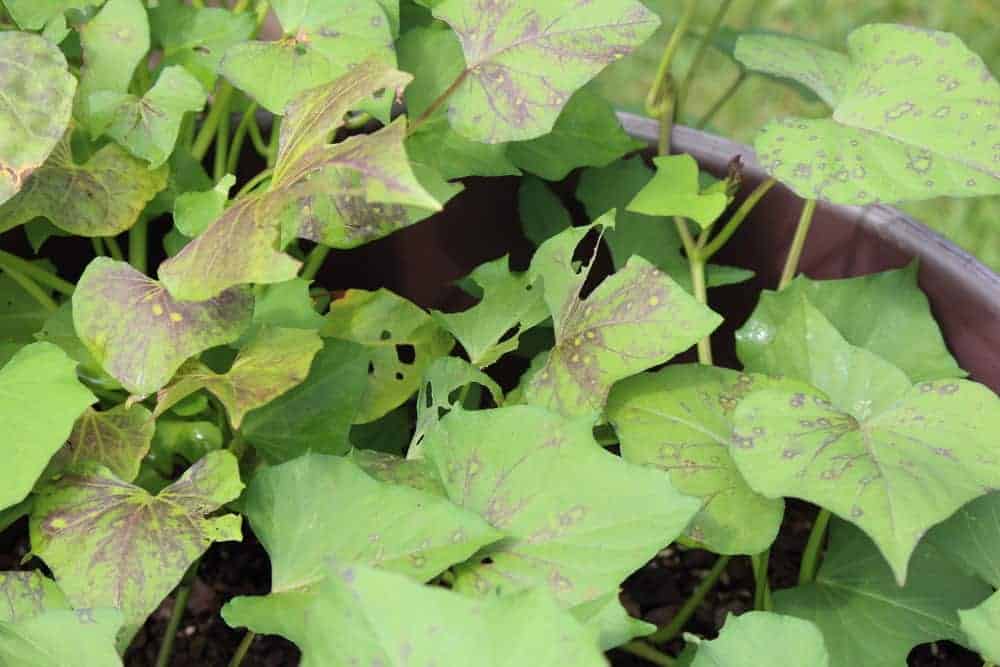Sweet potato (Yam) is a perennial plant, but most gardeners grow this veggie as annuals. They originated from tropical Americas, but it is one of the most favorite vegetables growing in the southern US. Grow these fantastic plants in your garden, container, or on a trellis, and enjoy lovely foliage, beautiful flowers, and tasty tubers.
The most familiar is an orange-fleshed variety, but you can grow yellow, white, and purple sweet potatoes as well. They are easy to grow, and just a couple of plants will bring you abundant yields approximately four months after planting rooted pieces of tubers. This nutritious veggie is resistant to drought, high temperatures, and most pests or diseases.
Why You Should Grow Sweet Potatoes
As one of the most useful food plants that you can grow in a warm region, sweet potatoes should find a place in your garden. The reasons are numerous:
- This vegetable may entirely replace regular potatoes
- This plant is highly nutritious and rich in vitamins A, C, B3, B6, and pantothenic acid
- It contains many essential minerals such as manganese, potassium, and copper
- By eating sweet potatoes, you will support your immune system
- The results of some studies show that regular consumption of this veggie may improve the function of the human brain
- Since this plant contains numerous antioxidants, some studies show that it may help with cancer protection
- They are tolerant of most pests and diseases
- Sweet potatoes require just a little fertilizer and water to grow healthy and vigorous
- They are delicious
- You can use young sweet potatoes as quick-growing ground cover or living mulch
- Sweet potatoes will keep weeds down
How to Plant Sweet Potatoes in Your Garden

Unlike most vegetables, you can’t start your sweet potatoes by seeds. You need to use slips from a mature sweet potato with shoots which are at least 2 to 3 inches (5 – 7.6 cm) long. In average, you can expect twelve slip sprouts from only one sweet potato.
You should start the process in November. Begin with cutting tubers on a few larger sections. Place each slip in a glass of water the way that half of it is above the water and half below its surface. Then, fix every piece by using toothpicks.
Put all the glasses on a sunny window and provide enough heat for the healthy growth of your future plants. After a few weeks, you will spot leafy sprouts on the top of each slip and tiny roots emerging from the bottom of each one piece.
Once your veggie has sprouted, you need to twist off each slide and lay it in a separate, shallow pot. Those slips are prepared for planting into the ground when the roots are about 1 inch (2.5 cm) long.
To get large, healthy tubers in the time of harvesting, you need to provide slightly acidic, loose, and well-drained soil for your sweet potatoes. Your veggies will enjoy growing in vermiculite, sand, or perlite. Dig 4 to 5 inches (10 – 13 cm) deep and 3 inches (7.6 cm) wide hole with a hand trowel, and put just one slip in each one of them.
Take care that the roots are pointed down, and the new leaves are above the surface of the ground. Plant your slips 12 to 18 inches (30.5 – 46 cm) apart and provide about 3 feet (91.5 cm) between rows to give the vines plenty of space for spreading. Cover all slips with enough soil and, press the ground around them gently.
After finishing planting, you should water your new plants adequately. Keep watering them every day for the first seven to ten days, and every other day during the next seven to ten days. The goal is to gradually reduce the frequency of watering by the moment you will water your plants once a week.
Most popular sweet potatoes’ varieties |
|
|
Georgia Jet |
You will experience a lot of advantages if you choose this variety well-known for its red skin and dark-orange flesh. Plus, it is a perfect choice for a region with a shorter growing season since it matures it only 90 days |
|
Centennial |
I like this variety because it is highly resistant to most common diseases, and matures in only 90 days |
|
Beauregard |
This is a wide-spread, commercial variety of a sweet potato with pale reddish skin. It will need approximately 100 days to reach maturity |
|
Bush Porto Rico |
This sweet potato, with copper skin and yummy orange flesh, needs about 110 days to mature. This variety is an ideal solution for you if your garden is small |
|
Patriot |
This copper-skinned sweet potato is well-known for excellent resistance to pests, which makes it the first choice for organic gardens |
How to Care Sweet Potatoes
The right spot

Before transplanting your sweet potatoes, keep young plants in a bright, sunny windowsill, far away from frost until late May or early June. When the time for transferring your plants outdoors comes, you need to provide a sheltered but sunny position for them.
Don’t forget to prepare the ground if necessary. Warm the soil with black polythene for a couple of weeks before planting and try to suppress the growth of weeds. Also, always keep in mind that your crop’s vines will cover a large area. Therefore, try to provide enough space for the free growth of your vegetables.
Light
Your sweet potatoes require full sun throughout a day, but they also need partial shade afternoon, especially if you live in a hot, dry area.
Soil
Provide the moisture-retentive, well-drained soil, which is high in organic matter, for your vegetables. They prefer that the pH of the ground is about 5 to 6.5. Before planting, mix just a few inches of compost with the soil, and that will be enough. Also, this crop is an ideal choice for areas with mostly sandy soil.
Mulching

If you estimate that you don’t need to use black plastic, just add some mulch around the vines fifteen days after planting. That is the way to reduce weeds and conserve moisture. Consequently, you will allow appropriate development of roots.
Lift longer vines from time to time to prevent rooting along the stem. That way, you will promote ripening of the main crop instead of letting plants put their energy for forming side, under-sized tubers.
Watering

Once established, your veggies will tolerate dry soil well. Add about 1 inch (2.5 cm) of water once a week regularly, especially if the weather is too dry. However, you shouldn’t water plants a month before harvesting to avoid splitting the mature tubers.
Temperature
You shouldn’t plant this crop outdoors until the temperature of the soil is not at least 60 F (15.5 C). The ideal temperatures of the ground needed for lush and healthy growth are from 60 to 85 F (15.5 – 29.5 C), while the temperatures of the air should be about 65 to 95 F (18 – 35 C).
Fertilizing

Since sweet potatoes are basically poor soil crops, you don’t need to fertilize your veggies at planting time since they don’t need too many nutrients at that particular moment. Plus, any possible excess of nitrogen will support the growth of foliage.
The best solution is to choose loose and nutrient-rich soil and mix it with well-aged compost in every planting hole. Additionally, you can add a continuous-release fertilizer rich in potassium, and that will be enough.
Weeding

Start with weeding around young sweet potatoes about two weeks after planting. Pull them gently and dig around every single plant. Avoid too deep digging to prevent damaging of your sweet potatoes with a hoe.
How to Harvest Sweet Potatoes

You can begin harvesting your tubers approximately four months after planting. The foliage is eatable either, and you can consume it throughout the season. However, take care to leave enough leaves to let your plants growing undisturbed.
Don’t let tubers sit in the soil too long after leaves dry up. Otherwise, you will face their rotting. Also, try to be gentle while digging since this plant’s tubers grow close to the soil’s surface and you can damage them easily.
The best way is to loosen a circle of 18 inches (46 cm) around the plant by using a digging fork, pull up the stem, and hand-pick sweet potatoes. Choose a sunny day to do this job while the soil is still dry.
How to Store Sweet Potatoes

After digging tubers, shake the soil off them, and dry them in the sun for a few hours. Move all tubers to a well-ventilated place where the temperatures are from 80 F to 90 F (27 – 32 C), and let them rest about two weeks.
During that period, any scratches in the sweet potatoes’ skins will heal, and your veggies will become more delicious and higher in nutrients. After curing, store them in the cold and dry space and provide the temperatures of 55 F (12.8 C) and a level of humidity of at least 75 to 80%. That way, you can keep these plants for about six months.
Avoid freezing raw tubers. The best solution is to blanch or boil your sweet potatoes before putting them in the freezer.
Also, you can wrap each tuber separately in the newspaper, and pack them in a basket or wooden box. You can store your veggies that way in a basement while the temperature is not lower than 50 F (10 C).
Sweet Potatoes Pests and Diseases
Sweet potato is a vigorous plant that often outgrows pest problems on its foliage. The real issue this veggie has with pests that attack its tubers.
Scurf

This soil-borne fungus disease may entirely devastate your crop. You can’t get rid of it once fungi infect the soil. The only way to avoid this disease is by purchasing certified disease-free plants.
Sweet potato weevil

It is a common pest of sweet potatoes in the tropics. These creatures will eat leaves, stems, and roots of your veggies. Moreover, they lay eggs among the roots, and its larvae cause their rotting by making tunnels through the healthy tissue.
You can avoid weevils if you rotate crops regularly and take care not to transfer these pests from one place to another. Also, planting disease-resistant slips can be useful. Don’t forget to destroy infected plants.
Whitefly

These small flies suck sap from the sweet potatoes foliage. Moreover, sticky ‘honeydew’ they excrete over the plant will attract sooty mold and encourage their growth. Get rid of them by using sticky traps or highly-effective biological control.
Sweet potato virus disease (SPVD)

It is a combination of mottle and stunts virus action. They can be spread through infected roots and vines, but the huge problem represents aphids and white-flies that transmit those causative agents from one plant to another.
Deer
These animals adore eating tender foliage of your sweet potatoes. Try to protect your crop by using floating row covers.

Leave a comment